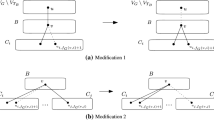Abstract
The oriented diameter of a (undirected) graph G is the smallest diameter among all the diameters of strongly connected orientations of G. We study algorithmic aspects of determining the oriented diameter of a chordal graph. We — give a linear time algorithm such that, for a given chordal graph G, either concludes that there is no strongly connected orientation of G, or finds a strongly connected orientation of G with diameter at most twice the diameter of G plus one; — prove that the corresponding decision problem remains NP-complete even when restricted to a small subclass of chordal graphs called split graphs; — show that unless P = NP, there is neither a polynomial-time absolute approximation algorithm nor an α-approximation (for every α< 3/2 ) algorithm computing oriented diameter of a chordal graph.
The work of IR and MM is partially supported by FONDAP on Applied Mathematics, Fondecyt 1020611 and Fondecyt 1010442. Part of this job was done while FVF was a postdoc at CMM, supported by FONDAP. FVF acknowledges support by EC contract IST-1999-14186, Project ALCOM-FT (Algorithms and Complexity - Future Technologies).
Access this chapter
Tax calculation will be finalised at checkout
Purchases are for personal use only
Preview
Unable to display preview. Download preview PDF.
Similar content being viewed by others
References
J. Bang-Jensen and G. Gutin, Digraphs, Springer-Verlag London Ltd., London, 2001. Theory, algorithms and applications.
A. Brandstädt, V. B. Le, and J. P. Spinrad, Graph classes: a survey, SIAM Monographs on Discrete Mathematics and Applications, Society for Industrial and Applied Mathematics, Philadelphia, 1999.
F. R. K. Chung, Diameters of communication networks, in Mathematics of information processing (Louisville, Ky., 1984), Amer. Math. Soc., Providence, R.I., 1986, pp. 1–18.
F. R. K. Chung, M. R. Garey, and R. E. Tarjan, Strongly connected orientations of mixed multigraphs, Networks, 15 (1985), pp. 477–484.
V. Chvátal and C. Thomassen, Distances in orientations of graphs, J. Combinatorial Theory Ser. B, 24 (1978), pp. 61–75.
G. Dirac, On rigid circuit graphs, Abhandl. Math. Sem. d. Univ. Hamburg, 25 (1961), pp. 71–76.
P. Fraigniaud and E. Lazard, Methods and problems of communication in usual networks, Discrete Appl. Math., 53 (1994), pp. 79–133.
M. C. Golumbic, Algorithmic Graph Theory and Perfect Graphs, Academic Press, New York, 1980.
G. Gutin, Minimizing and maximizing the diameter in orientations of graphs, Graphs Combin., 10 (1994), pp. 225–230.
S. M. Hedetniemi, S. T. Hedetniemi, and A. L. Liestman, A survey of gossiping and broadcasting in communication networks, Networks, 18 (1988), pp. 319–349.
K. M. Koh and E. G. Tay, On optimal orientations of Cartesian products of even cycles, Networks, 32 (1998), pp. 299–306.
J.-C. Konig, D. W. Krumme, and E. Lazard, Diameter-preserving orientations of the torus, Networks, 32 (1998), pp. 1–11.
L. Lovász, Coverings and coloring of hypergraphs, in Proceedings of the Fourth Southeastern Conference on Combinatorics, Graph Theory, and Computing (Florida Atlantic Univ., Boca Raton, Fla., 1973), Utilitas Math., Winnipeg, Man., 1973, pp. 3–12.
H. E. Robbins, A theorem on graphs with an application to a problem of traffic control, Amer. Math. Monthly, 46 (1939), pp. 281–283.
F. S. Roberts, Graph theory and its applications to problems of society, Society for Industrial and Applied Mathematics (SIAM), Philadelphia, Pa., 1978.
F. S. Roberts and Y. Xu, On the optimal strongly connected orientations of city street graphs. I. Large grids, SIAM J. Discrete Math., 1 (1988), pp. 199–222.
D. J. Rose, R. E. Tarjan, and G. S. Lueker, Algorithmic aspects of vertex elimination on graphs, SIAM J. Comput., 5 (1976), pp. 266–283.
L. Šoltés, Orientations of graphs minimizing the radius or the diameter, Math. Slovaca, 36 (1986), pp. 289–296.
R. E. Tarjan, Depth first search and linear graph algorithms, SIAM Journal on Computing, 1 (1972), pp. 146–160.
Author information
Authors and Affiliations
Editor information
Editors and Affiliations
Rights and permissions
Copyright information
© 2002 Springer-Verlag Berlin Heidelberg
About this paper
Cite this paper
Fomin, F.V., Matamala, M., Rapaport, I. (2002). The Complexity of Approximating the Oriented Diameter of Chordal Graphs. In: Goos, G., Hartmanis, J., van Leeuwen, J., Kučera, L. (eds) Graph-Theoretic Concepts in Computer Science. WG 2002. Lecture Notes in Computer Science, vol 2573. Springer, Berlin, Heidelberg. https://doi.org/10.1007/3-540-36379-3_19
Download citation
DOI: https://doi.org/10.1007/3-540-36379-3_19
Published:
Publisher Name: Springer, Berlin, Heidelberg
Print ISBN: 978-3-540-00331-1
Online ISBN: 978-3-540-36379-8
eBook Packages: Springer Book Archive




